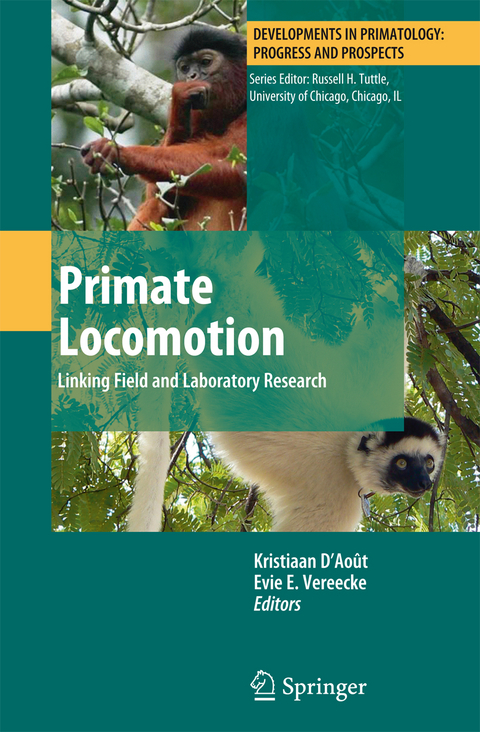
Primate Locomotion
Springer-Verlag New York Inc.
978-1-4614-2777-3 (ISBN)
Primate locomotion has typically been studied from two points of view. Laboratory-based researchers have focused on aspects like biomechanics and energetics, whereas field-based researchers have focused on (locomotor) behaviour and ecology. Unfortunately, to date, there is relatively little scientific exchange between both groups. With a book, which will be the result of a symposium on the 2008 Meeting of the International Primatological Society in Edinburgh, we would like to bring together laboratory and field-based primate locomotion studies. We are convinced this will be beneficial for both research lines. For example, biomechanists might wonder how frequently the locomotor style they study in the lab actually occurs in nature, and field workers might use calculated costs of locomotion to understand why certain locomotor behaviours are favoured under specific conditions. Thus, on the one hand, an established link between both groups may help interpret the results by using each other’s findings. On the other hand, recent technological advances (e.g. portable high-speed cameras) make it possible to bridge the gap between lab-based and field-based research by actually collecting biomechanical data in situ. Again, communication between both groups is necessary to identify the specific needs and start up achievable and successful research projects in the field. In order to generate a wide interest, we have invited biomechanists, ecologists, and field-based researchers who combine both disciplines, and we hope their combined contributions will facilitate lasting cooperation between the mentioned disciplines and stimulate innovative research in Primatology.
We are convinced that the most appropriate format to publish the different symposium contributions is a conference volume within an existing book series. Firstly, the chapters will not only contain new data but will also review existing data and elaborate on potential future work – more so than can bedone in a journal article.
Secondly, the combination of chapters will form an entity that is more valuable than the sum of the separate chapters and therefore they need to be presented together. Lastly, this volume will benefit from the typically long "shelf life" of a book in a renowned series, allowing it to be used as reference book for both researchers and students.
Foreword
Tuttle RH
Chapter 1: Introduction: Primate locomotion – towards a synergy of laboratory and field research.
Vereecke AA & D’Août K
Chapter 2: Translating primate locomotor biomechanical variables from the laboratory to the field.
Schmitt D
Chapter 3: Studying captive ape locomotion: past, present and future.
Vereecke EE, D’Août K & Aerts P
Chapter 4: Experimental and computational studies of bipedal locomotion in the bipedally-trained Japanese macaque.
Ogihara N, Hirasaki E & Nakatsukasa M
Chapter 5: In what manner do quadrupedal primates walk on two legs? Preliminary results on Olive Baboons (Papio anubis).
Berillon G, D’Août K, Daver G, Dubreuil G, Multon F, Nicolas G & de la Villetanet B
Chapter 6: Scapula movements and their contribution to three-dimensional forelimb excursions in quadruped primates.
Schmidt M & Krause C
Chapter 7: The influence of load carrying on gait parameters in humans and apes: implications for the evolution of human bipedalism.
Watson J, Payne R, Chamberlain A, Jones R & Sellers W
Chapter 8: Field and experimental approaches to the study of locomotor ontogeny in Propithecus verreauxi.
Wunderlich RE, Lawler RR & Williams AE
Chapter 9: Comparisons of limb structural properties in free-ranging chimpanzees from Kibale, Gombe, Mahale, and Taï communities.
Carlson KJ, Wrangham RW, Muller MN, Sumner DR, Morbeck ME, Nishida T, Yamanaka A & Boesch C
Chapter 10: Field study methods for primate locomotion.
Blanchard M, Sellers WI & Crompton RH
Chapter 11: Gibbon locomotion research in the field – problems, possibilities and benefits for conservation.
Cheyne SM
Chapter 12: Posture, ischial tuberosities and tree zone use is West African cercopithecids
McGraw & Sciulli PW.
Chapter 13: Forelimb suspensory gait characteristics of wild Lagothrix poeppigii and Ateles belzebuth: developing video based methodologies in free-ranging primates.
Guillot DM
Chapter 14: Gait and kinematics of arboreal quadrupedal walk of free-ranging red howlers (Alouatta seniculus) in French Guiana.
Youlatos D & Gasc J-P
Chapter 15: Fromtreadmill to tropics: calculating ranging cost in chimpanzees.
Pontzer H, Raichlen DA & Sockol MD
Chapter 16: Linking field and laboratory approaches for studying primate locomotor responses to support orientation.
Stevens NJ, Ratsimbazafy JH & Ralainasolo F
Chapter 17: Quadrupedal locomotion of Saimiri boliviensis: a comparison of field and lab-based kinematic data.
Shapiro LJ, Young JW & Souther A
| Reihe/Serie | Developments in Primatology: Progress and Prospects |
|---|---|
| Zusatzinfo | XVI, 364 p. |
| Verlagsort | New York, NY |
| Sprache | englisch |
| Maße | 155 x 235 mm |
| Themenwelt | Naturwissenschaften ► Biologie ► Evolution |
| Naturwissenschaften ► Biologie ► Genetik / Molekularbiologie | |
| Naturwissenschaften ► Biologie ► Zoologie | |
| Sozialwissenschaften ► Soziologie | |
| ISBN-10 | 1-4614-2777-0 / 1461427770 |
| ISBN-13 | 978-1-4614-2777-3 / 9781461427773 |
| Zustand | Neuware |
| Haben Sie eine Frage zum Produkt? |
aus dem Bereich


